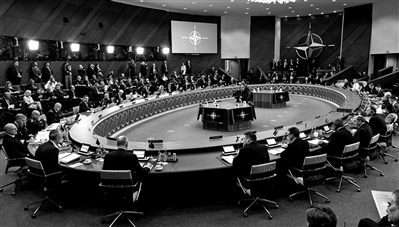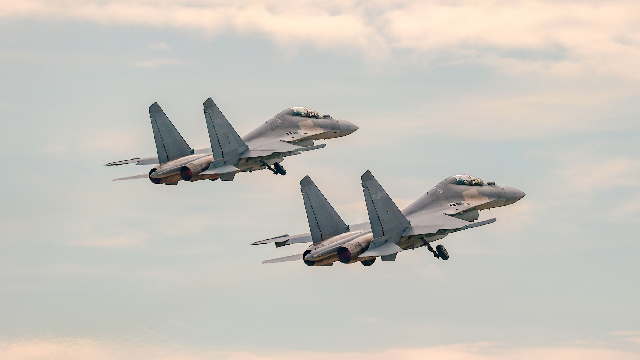By Ji Cheng

The picture shows a NATO defense ministers meeting. (File photo)
At a recent meeting of NATO defense ministers at the NATO headquarters in Brussels, NATO Secretary General Jens Stoltenberg stated that all NATO member states should consider the annual defense spending target – 2% of their GDP – as a "minimum" rather than a "maximum".
Against the context of the protracted and complex conflict between Russia and Ukraine, NATO's practice of raising defense spending and keeping increasing military assistance to Ukraine will aggravate the conflict situation, be detrimental to realizing a ceasefire and cessation of war at the earliest possible, and even will deal a serious blow and damage to the security situation in Europe. At the same time, the strategic autonomy process in Europe will also stagnate or even regress due to the strategic coercion of the US and NATO.
A defense spending of 2% is no longer the minimum target
According to the official statistics of NATO, the total annual defense expenditure of NATO in 2022 exceeded one trillion US dollars. It is expected that the defense spending of at least 19 NATO member states will exceed 2% of their GDP as of 2024, approaching two-thirds of the total number of NATO members. Specifically, the US, Germany, and France act as important drivers of NATO's increase in defense spending standards, as well as the momentum builders in public opinion and bellwethers in action.
Currently, the annual defense budget of the US accounts for as much as 3.5% of its GDP, far above the minimum standard of 2% set by NATO, and even exceeding the total military expenditures of all other NATO members. French President Macron stated in January that the total defense budget of France will be elevated to 413 billion euros for the 2024-2030 term, an increase of about one-third compared to the previous seven-year period. German Defense Minister Boris Pistorius called for an increase of 10 billion euros per year in the annual budget of Germany’s armed forces in 2024, and said that thedefense spending target of 2% of the GDP could only serve as the basis for NATO to take further measures, which is clearly creating momentum for subsequent additional funding.
Some Eastern European, Nordic, and Baltic countries have vigorously responded to NATO's defense spending increase. According to NATO sources, the Baltic republics of Estonia, Latvia, and Lithuania and related Eastern European countries have proposed to have the current 2% of the GDP target raised to 2.5% at the NATO defense ministers meeting. Poland, among others, will increase the proportion of its defense budget in GDP to 4% in 2023, a significant jump from 2.4% in 2022. Once the plan gets into implementation, Poland will become a NATO member with the highest share of defense spending in GDP.
The US to shackle Europe by Russia-Ukraine conflict
Europe has once resisted or deliberately delayed the US' request to increase NATO military spending since the end of the Cold War. In fact, most of the European countries in NATO have reduced their defense spending during the post-Cold War period, which has made the US quite dissatisfied. However, with the outbreak of the Russia-Ukraine conflict, the US has successfully put the shackles back on its European allies, making them yield step by step to the dual pressures of security difficulties and values, and finally embark on the path as set by the US for them.
Four months after the outbreak of the Russia-Ukraine conflict, NATO issued the 2022 Strategic Concept, NATO's guiding document, which pointed out that the competition among major powers and the resulting cyclical turbulence are profoundly shaping the security environment of NATO. The document also defined Russia as the “most significant and direct threat” to NATO members’ peace and security. Such an understanding of the current and future strategic environment undoubtedly serves to lay the groundwork for increasing military spending.
To tie the allies firmly to its chariots, the US has been fearmongering while repeatedly urging its allies to increase military spending. At the NATO defense ministers Meeting, US Defense Secretary Lloyd Austin expressed the hope of reaching an agreement with the US allies on a new defense investment pledge at the NATO summit this summer, so as to jointly upgrade the alliance's defense plan and improve the combat readiness level of the troops.
"Adding fuel to the fire" is bound to exacerbate security-related risks
For the US, encouraging its allies to increase defense budgets can effectively reduce its own defense burden in Europe, and so it can shift more resources to the Indo-Pacific region. This move can be regarded as a way to maintain the US leadership in European security affairs in a "low-cost and efficient" manner. However, for other NATO members, no matter how the US plays up the current security threat, there are still many difficulties facing them in actually increasing their defense spending.
The Russia-Ukraine conflict has produced serious spillover effects. The energy crisis, inflation crisis and food crisis the conflict has brought have left many NATO members of Europe with financial constraints. In this situation, blindly increasing defense spending will inevitably divert expenditure targeting other aspects, especially that those related to people's livelihood, thereby shaking the governance foundation of the government. The recent anti-war protests in countries including Germany, France, and Italy have spoken volumes about this.
The increase in defense spending of European countries may only be a stress reaction under the Russia-Ukraine conflict. Although temporarily tied to the US chariot and cannot move, these countries may not unconditionally cater to the US' hegemonic considerations for long. For European members of NATO, consolidating the strategic autonomy of European defense is supposed to be their primary concern. It is worth mentioning that under the constraint of the US "great power competition" strategy, NATO's Asian-Pacific expansion and globalization are growing increasingly apparent. This may sow the seeds of disagreement between the US and Europe, as well as within European countries, on the issue of defense spending.
(The author is from the PLA Academy of Military Sciences)









